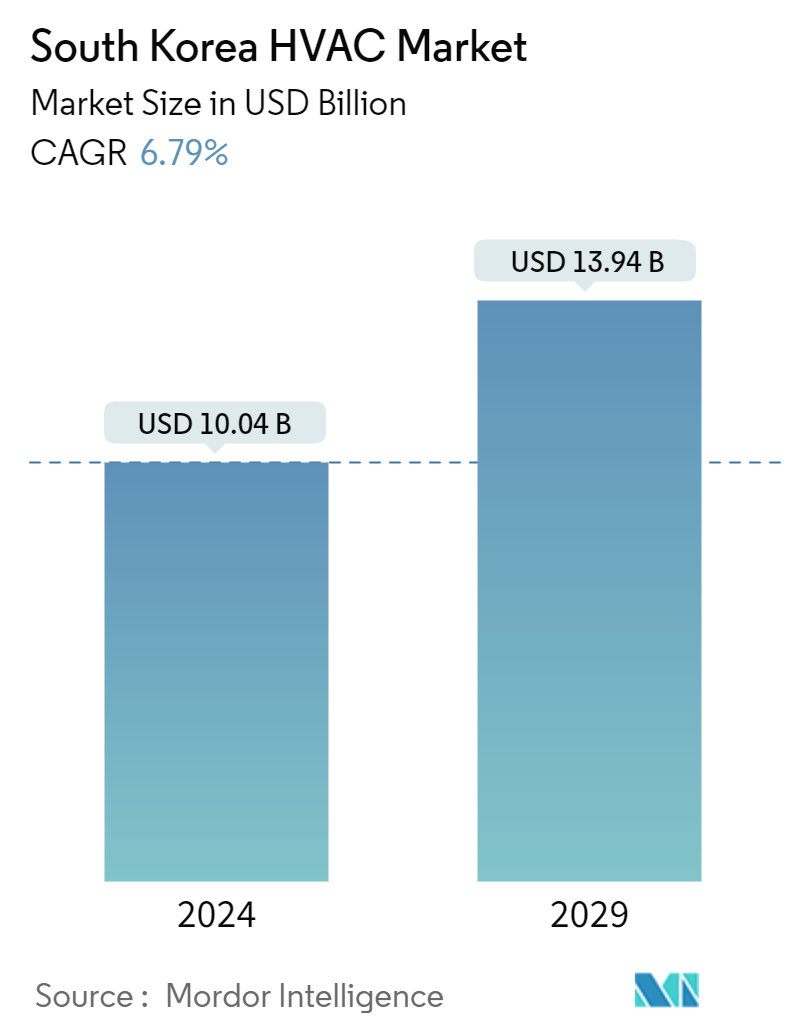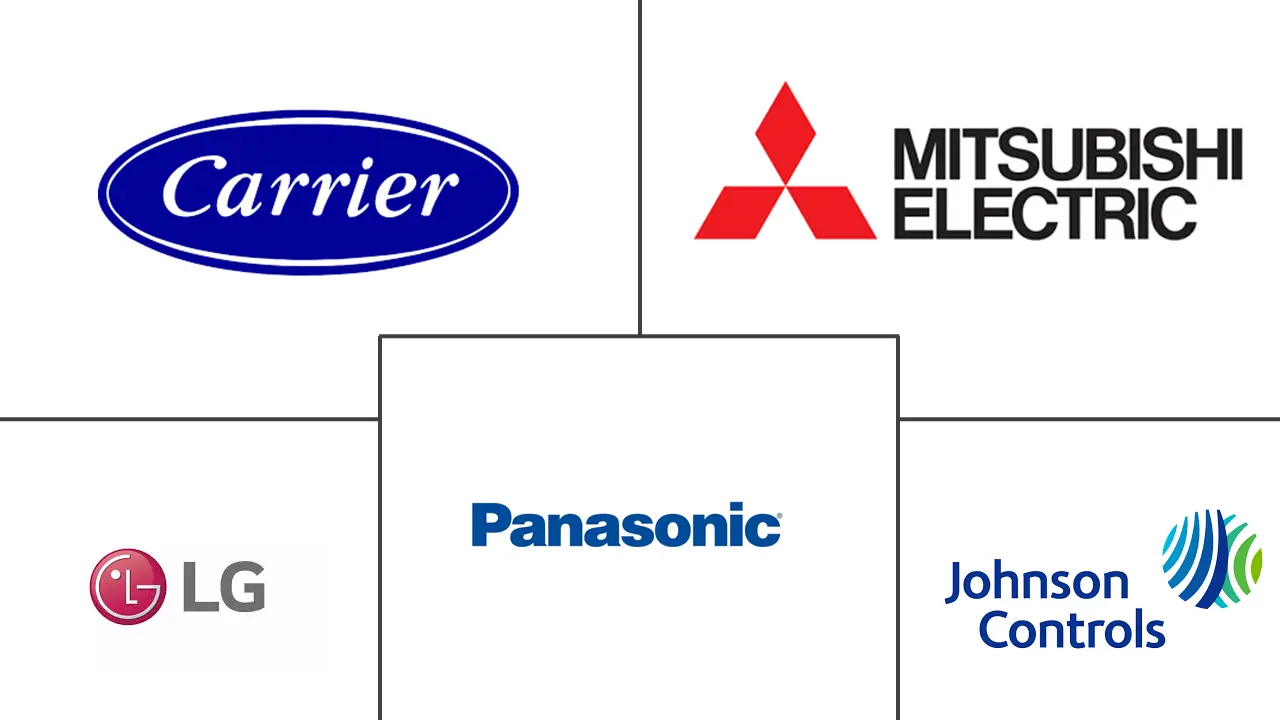Market Size of South Korea HVAC Industry

| Study Period | 2019 - 2029 |
| Base Year For Estimation | 2023 |
| Market Size (2024) | USD 10.04 Billion |
| Market Size (2029) | USD 13.94 Billion |
| CAGR (2024 - 2029) | 6.79 % |
| Market Concentration | Low |
Major Players
*Disclaimer: Major Players sorted in no particular order |
South Korea HVAC Market Analysis
The South Korea HVAC Market size is estimated at USD 10.04 billion in 2024, and is expected to reach USD 13.94 billion by 2029, growing at a CAGR of 6.79% during the forecast period (2024-2029).
- HVAC equipment is necessary for maintaining a comfortable environment within industrial, residential, and commercial buildings. For instance, these systems are commonly found in office spaces to regulate temperature and ensure proper ventilation, ultimately enhancing employee efficiency and well-being while reducing potential health hazards associated with poor humidity control.
- The South Korean HVAC market is anticipated to experience significant growth in the coming years owing to rising disposable incomes, expanding construction activity, and a greater emphasis on energy efficiency.
- In 2023, the Construction Association of Korea reported that the value of domestic construction orders from private owners in South Korea reached about KRW 125.5 trillion (USD 0.091 trillion), making private owners the primary contributors to the total value of construction orders received. The total value of domestic construction orders was approximately KRW 190 trillion (USD 0.14 trillion).
- Furthermore, the government's rising initiative to increase the private housing sector is expected to drive the country's demand for HVAC equipment and services. For instance, in September 2023, the South Korean government plans to provide an additional 120,000 public homes on top of the current initiative to construct 2.7 million new homes by 2027 to counteract the decrease in private-sector home supply due to increased lending rates.
- An HVAC system comprises various components, including home size, HVAC type, brand, labor expenses, climate, ductwork size, and energy efficiency. These components result in a significant overall cost, which hampers the market’s growth.
- The HVAC market in South Korea is fragmented, with a large number of players occupying a small market share. Prominent vendors operating in the HVAC market are focusing on new product development, strategic partnerships, acquisition, and expansion to meet the growing customer demand, further supporting the market’s growth.
- Moreover, ground source heat pumps (GSHP) are gaining popularity in South Korea for both space heating and cooling. With the country's limited availability of high-temperature geothermal energy sources, the primary direct geothermal uses are public baths (25-40°C) and geothermal heat pumps (~15°C) that utilize low-temperature groundwater or ground sources.
- In March 2023, South Korean researchers successfully developed a heat trading system for district heating during peak solar production hours. This innovative system includes a ground-source heat pump, solar thermal collectors, a fuel-cell system, and two heat storage tanks. These advancements are expected to contribute to the market's growth.
- Moreover, the HVAC market in South Korea is highly affected by macroeconomic factors such as government regulations and new initiatives to boost the adoption of energy-efficient equipment. In addition to this, the increase in inflation typically results in higher expenses for materials, labor, and energy in the production and installation of HVAC systems, often resulting in higher prices for new installations.
South Korea HVAC Industry Segmentation
Heating, ventilation, and air conditioning (HVAC) is a technology that ensures indoor and vehicular comfort by regulating thermal conditions and maintaining acceptable indoor air quality.
The study tracks the revenue accrued through the sale of HVAC equipment and services by various players in the South Korean market. The study also tracks the key market parameters, underlying growth influencers, and major vendors operating in the industry, which supports the market estimations and growth rates during the forecast period. The study further analyses the overall impact of COVID-19 aftereffects and other macroeconomic factors on the market. The report’s scope encompasses market sizing and forecasts for the various market segments.
The South Korean HVAC market is segmented by components (HVAC equipment [heating equipment and air conditioning/ventilation equipment] and HVAC services) and by end-user industry (residential, commercial, industrial). The market sizes and forecasts are provided in terms of value (USD) for all the above segments.
| By Type of Component | ||||
| ||||
| HVAC Services |
| By End User Industry | |
| Residential | |
| Commercial | |
| Industrial |
South Korea HVAC Market Size Summary
The South Korea HVAC market is poised for substantial growth over the forecast period, driven by increasing disposable incomes, expanding construction activities, and a heightened focus on energy efficiency. HVAC systems play a crucial role in maintaining comfortable environments across industrial, residential, and commercial spaces, contributing to enhanced productivity and well-being. The market is characterized by a fragmented landscape with numerous players striving to capture market share through product innovation, strategic partnerships, and expansions. Government initiatives to boost the private housing sector and the construction of new homes are expected to further stimulate demand for HVAC equipment and services. Additionally, the adoption of ground source heat pumps and advancements in heat trading systems are indicative of the market's shift towards more sustainable and energy-efficient solutions.
The demand for HVAC systems in South Korea is also influenced by macroeconomic factors such as government regulations and initiatives promoting energy-efficient equipment. The construction industry's rapid growth, coupled with the increasing need for efficient air conditioning systems in commercial structures, is expected to positively impact the market. The government's financial backing for sustainable community development and urban revitalization projects is anticipated to drive the adoption of high-tech, energy-efficient HVAC systems. Major players in the market, including Panasonic, Mitsubishi Electric, and LG Electronics, are actively introducing new products and technologies to meet the evolving needs of consumers. These developments, alongside the rising awareness of the benefits of energy-efficient systems, are expected to contribute to the market's robust growth trajectory.
South Korea HVAC Market Size - Table of Contents
-
1. MARKET INSIGHTS
-
1.1 Market Overview
-
1.2 Industry Attractiveness - Porter's Five Forces Analysis
-
1.2.1 Bargaining Power of Suppliers
-
1.2.2 Bargaining Power of Consumers
-
1.2.3 Threat of New Entrants
-
1.2.4 Threat of Substitute Products
-
1.2.5 Intensity of Competitive Rivalry
-
-
1.3 Industry Value Chain Analysis
-
1.4 Impact of COVID-19 Aftereffects and Other Macroeconomic Factors on the Market
-
-
2. MARKET SEGMENTATION
-
2.1 By Type of Component
-
2.1.1 HVAC Equipment
-
2.1.1.1 Heating Equipment
-
2.1.1.2 Air Conditioning /Ventilation Equipment
-
-
2.1.2 HVAC Services
-
-
2.2 By End User Industry
-
2.2.1 Residential
-
2.2.2 Commercial
-
2.2.3 Industrial
-
-
South Korea HVAC Market Size FAQs
How big is the South Korea HVAC Market?
The South Korea HVAC Market size is expected to reach USD 10.04 billion in 2024 and grow at a CAGR of 6.79% to reach USD 13.94 billion by 2029.
What is the current South Korea HVAC Market size?
In 2024, the South Korea HVAC Market size is expected to reach USD 10.04 billion.

